2017 TOYOTA SIENNA fuel pressure
[x] Cancel search: fuel pressurePage 6 of 672
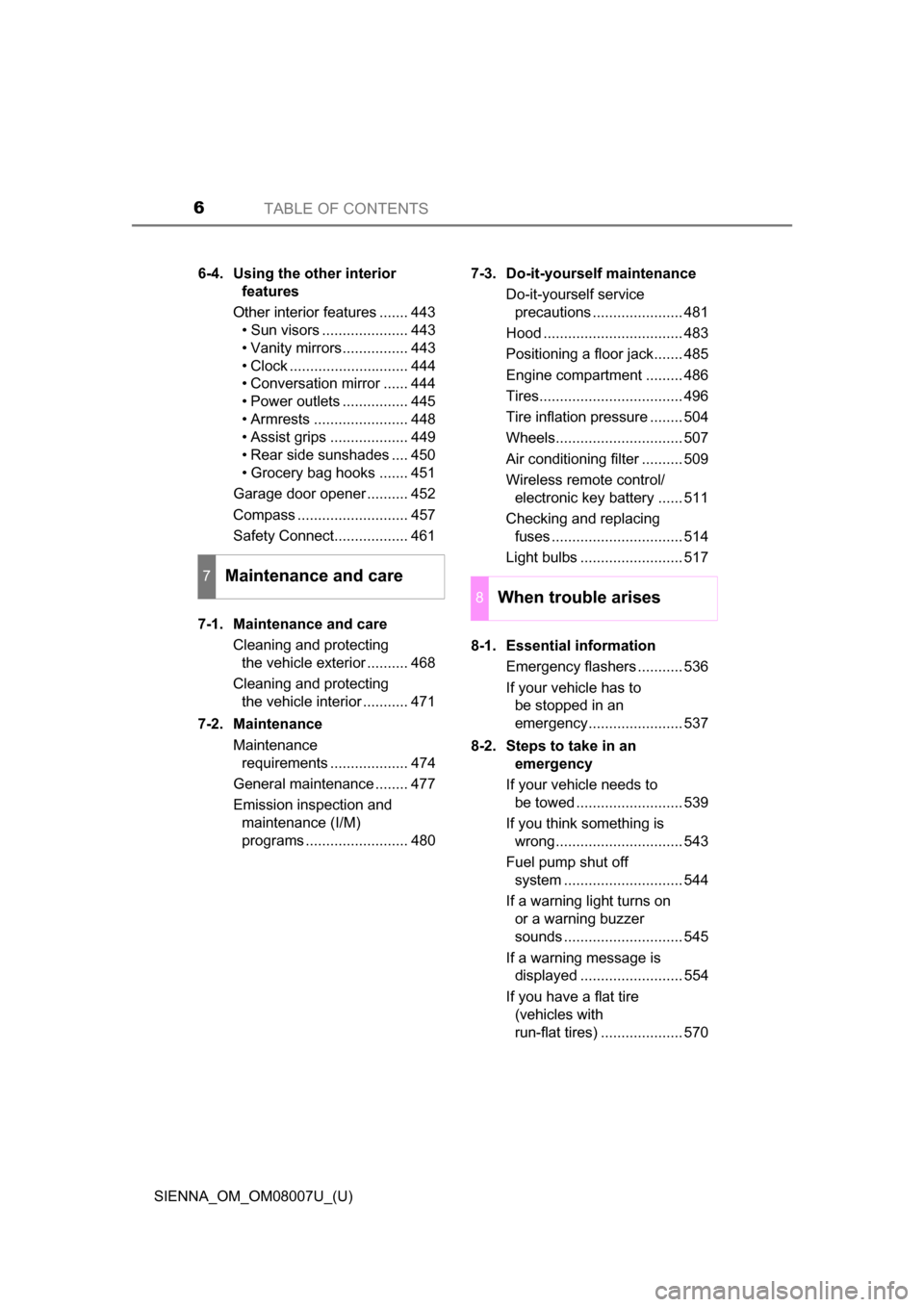
TABLE OF CONTENTS6
SIENNA_OM_OM08007U_(U)6-4. Using the other interior
features
Other interior features ....... 443 • Sun visors ..................... 443
• Vanity mirrors................ 443
• Clock ............................. 444
• Conversation mirror ...... 444
• Power outlets ................ 445
• Armrests ....................... 448
• Assist grips ................... 449
• Rear side sunshades .... 450
• Grocery bag hooks ....... 451
Garage door opener .......... 452
Compass ........................... 457
Safety Connect.................. 461
7-1. Maintenance and care Cleaning and protecting the vehicle exterior .......... 468
Cleaning and protecting the vehicle interior ........... 471
7-2. Maintenance Maintenance requirements ................... 474
General maintenance ........ 477
Emission inspection and maintenance (I/M)
programs ......................... 480 7-3. Do-it-yourself maintenance
Do-it-yourself service precautions ...................... 481
Hood .................................. 483
Positioning a floor jack....... 485
Engine compartment ......... 486
Tires................................... 496
Tire inflation pressure ........ 504
Wheels............................... 507
Air conditioning filter .......... 509
Wireless remote control/ electronic key battery ...... 511
Checking and replacing fuses ................................ 514
Light bulbs ......................... 517
8-1. Essential information Emergency flashers ........... 536
If your vehicle has to be stopped in an
emergency....................... 537
8-2. Steps to take in an emergency
If your vehicle needs to be towed .......................... 539
If you think something is wrong............................... 543
Fuel pump shut off system ............................. 544
If a warning light turns on or a warning buzzer
sounds ............................. 545
If a warning message is displayed ......................... 554
If you have a flat tire (vehicles with
run-flat tires) .................... 570
7Maintenance and care
8When trouble arises
Page 15 of 672
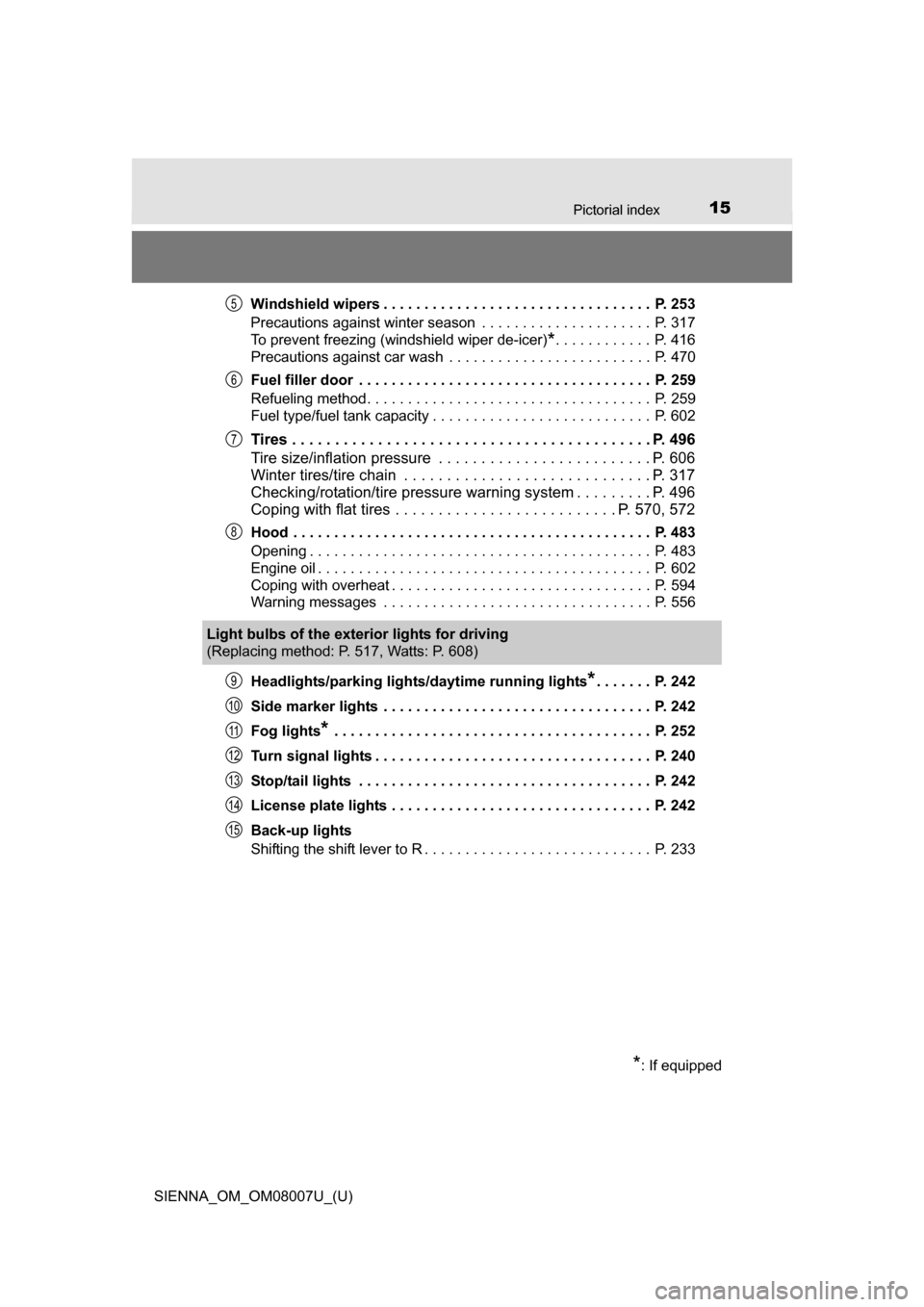
15Pictorial index
SIENNA_OM_OM08007U_(U)Windshield wipers . . . . . . . . . . . . . . . . . . . . . . . . . . . . . . . . . P. 253
Precautions against winter season . . . . . . . . . . . . . . . . . . . . . P. 317
To prevent freezing (windshield wiper de-icer)
*. . . . . . . . . . . . P. 416
Precautions against car wash . . . . . . . . . . . . . . . . . . . . . . . . . P. 470
Fuel filler door . . . . . . . . . . . . . . . . . . . . . . . . . . . . . . . . . . . . P. 259
Refueling method. . . . . . . . . . . . . . . . . . . . . . . . . . . . . . . . . . . P. 259
Fuel type/fuel tank capacity . . . . . . . . . . . . . . . . . . . . . . . . . . . P. 602
Tires . . . . . . . . . . . . . . . . . . . . . . . . . . . . . . . . . . . . . . . . . . P. 496
Tire size/inflation pressure . . . . . . . . . . . . . . . . . . . . . . . . . P. 606
Winter tires/tire chain . . . . . . . . . . . . . . . . . . . . . . . . . . . . . P. 317
Checking/rotation/tire pressure warning system . . . . . . . . . P. 496
Coping with flat tires . . . . . . . . . . . . . . . . . . . . . . . . . . P. 570, 572
Hood . . . . . . . . . . . . . . . . . . . . . . . . . . . . . . . . . . . . . . . . . . . . P. 483
Opening . . . . . . . . . . . . . . . . . . . . . . . . . . . . . . . . . . . . . . . . . . P. 483
Engine oil . . . . . . . . . . . . . . . . . . . . . . . . . . . . . . . . . . . . . . . . . P. 602
Coping with overheat . . . . . . . . . . . . . . . . . . . . . . . . . . . . . . . . P. 594
Warning messages . . . . . . . . . . . . . . . . . . . . . . . . . . . . . . . . . P. 556
Headlights/parking lights/ daytime running lights
*. . . . . . . P. 242
Side marker lights . . . . . . . . . . . . . . . . . . . . . . . . . . . . . . . . . P. 242
Fog lights
* . . . . . . . . . . . . . . . . . . . . . . . . . . . . . . . . . . . . . . . P. 252
Turn signal lights . . . . . . . . . . . . . . . . . . . . . . . . . . . . . . . . . . P. 240
Stop/tail lights . . . . . . . . . . . . . . . . . . . . . . . . . . . . . . . . . . . . P. 242
License plate lights . . . . . . . . . . . . . . . . . . . . . . . . . . . . . . . . P. 242
Back-up lights
Shifting the shift lever to R . . . . . . . . . . . . . . . . . . . . . . . . . . . . P. 233
5
6
7
8
Light bulbs of the exterior lights for driving
(Replacing method: P. 517, Watts: P. 608)
*: If equipped
9
10
11
12
13
14
15
Page 83 of 672

SIENNA_OM_OM08007U_(U)
832. Instrument cluster
2
Instrument cluster
Warning lights inform the driver of malfunctions in the indicated vehi-
cle’s systems.
Warning lights
*1
(U.S.A.)
Brake system warning
light ( P. 545)
*1Electric power steering
system warning light
(P. 546)
*1
(Canada)
Brake system warning
light ( P. 545)
*1, 2, 3
Pre-collision system
warning light ( P. 546)
*1, 2Charging system
warning light (P. 545)*1
Slip indicator ( P. 546)
*1, 2Low engine oil pressure
warning light
(P. 545)
*2Open door warning light
( P. 547)
*1
(U.S.A.)
Malfunction indicator
lamp ( P. 545) Low fuel level warning
light (
P. 547)
*1
(Canada)
Malfunction indicator
lamp ( P. 545) Seat belt reminder light
(
P. 547)
*1SRS warning light
(P. 546)*1Master warning light
(P. 547)
*1
(U.S.A.)
ABS warning light
(P. 546)
*1
Tire pressure warning
light ( P. 547)
*1
(Canada)
ABS warning light
(P. 546)
*2
Third seat warning light
(P. 547)
Page 468 of 672
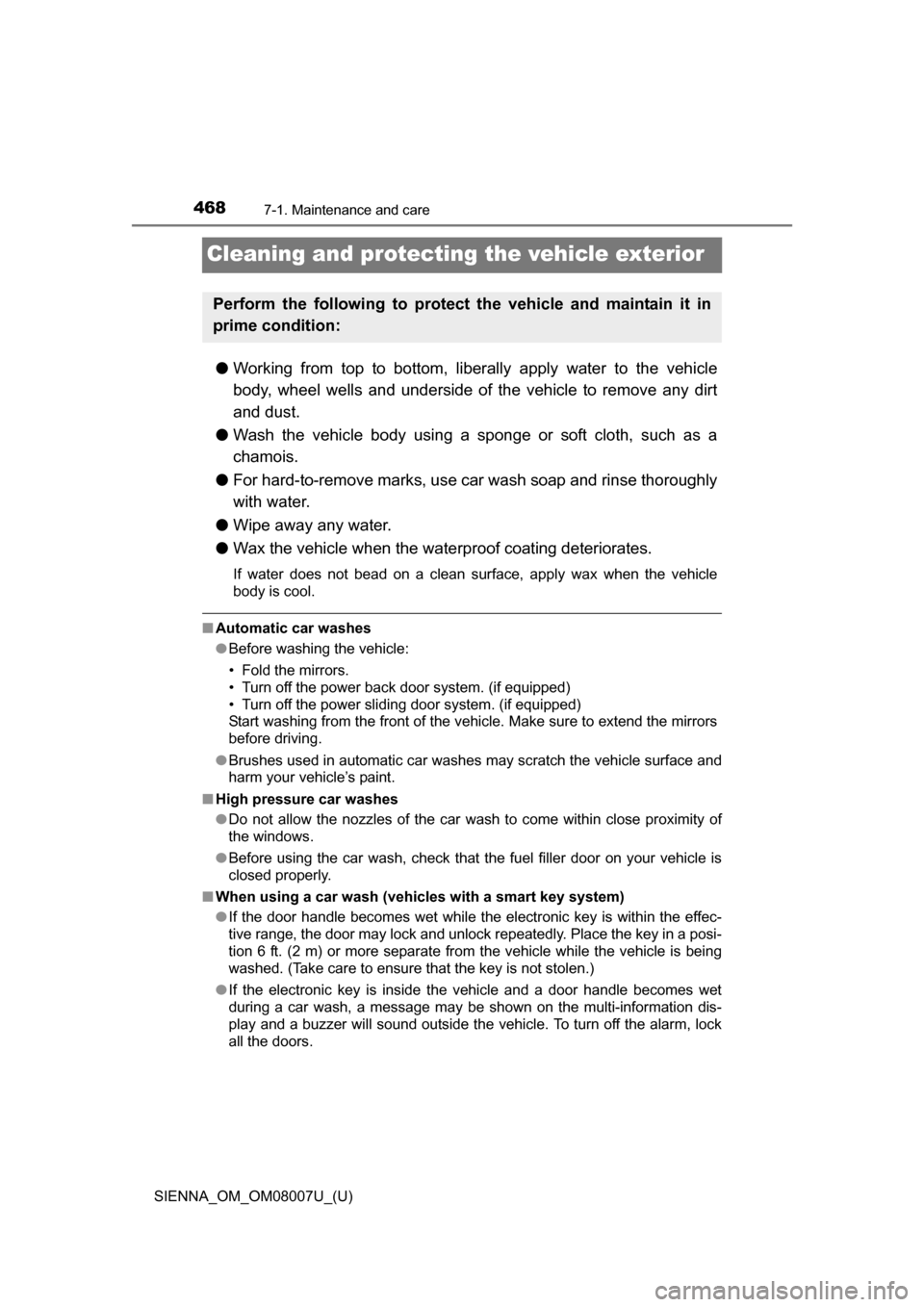
468
SIENNA_OM_OM08007U_(U)
7-1. Maintenance and care
Cleaning and protecting the vehicle exterior
●Working from top to bottom, liber ally apply water to the vehicle
body, wheel wells and underside of the vehicle to remove any dirt
and dust.
● Wash the vehicle body using a sponge or soft cloth, such as a
chamois.
● For hard-to-remove marks, use car wash soap and rinse thoroughly
with water.
● Wipe away any water.
● Wax the vehicle when the wate rproof coating deteriorates.
If water does not bead on a clean surface, apply wax when the vehicle
body is cool.
■Automatic car washes
●Before washing the vehicle:
• Fold the mirrors.
• Turn off the power back door system. (if equipped)
• Turn off the power sliding door system. (if equipped)
Start washing from the front of the vehicle. Make sure to extend the mirrors
before driving.
● Brushes used in automatic car washes may scratch the vehicle surface and
harm your vehicle’s paint.
■ High pressure car washes
●Do not allow the nozzles of the car wash to come within close proximity of
the windows.
● Before using the car wash, check that the fuel filler door on your vehicle is
closed properly.
■ When using a car wash (veh icles with a smart key system)
● If the door handle becomes wet while the electronic key is within the effec-
tive range, the door may lock and unlock repeatedly. Place the key in a posi-
tion 6 ft. (2 m) or more separate from the vehicle while the vehicle is being
washed. (Take care to ensure that the key is not stolen.)
● If the electronic key is inside the vehicle and a door handle becomes wet
during a car wash, a message may be shown on the multi-information dis-
play and a buzzer will sound outside the vehicle. To turn off the alarm, lock
all the doors.
Perform the following to protect the vehicle and maintain it in
prime condition:
Page 505 of 672
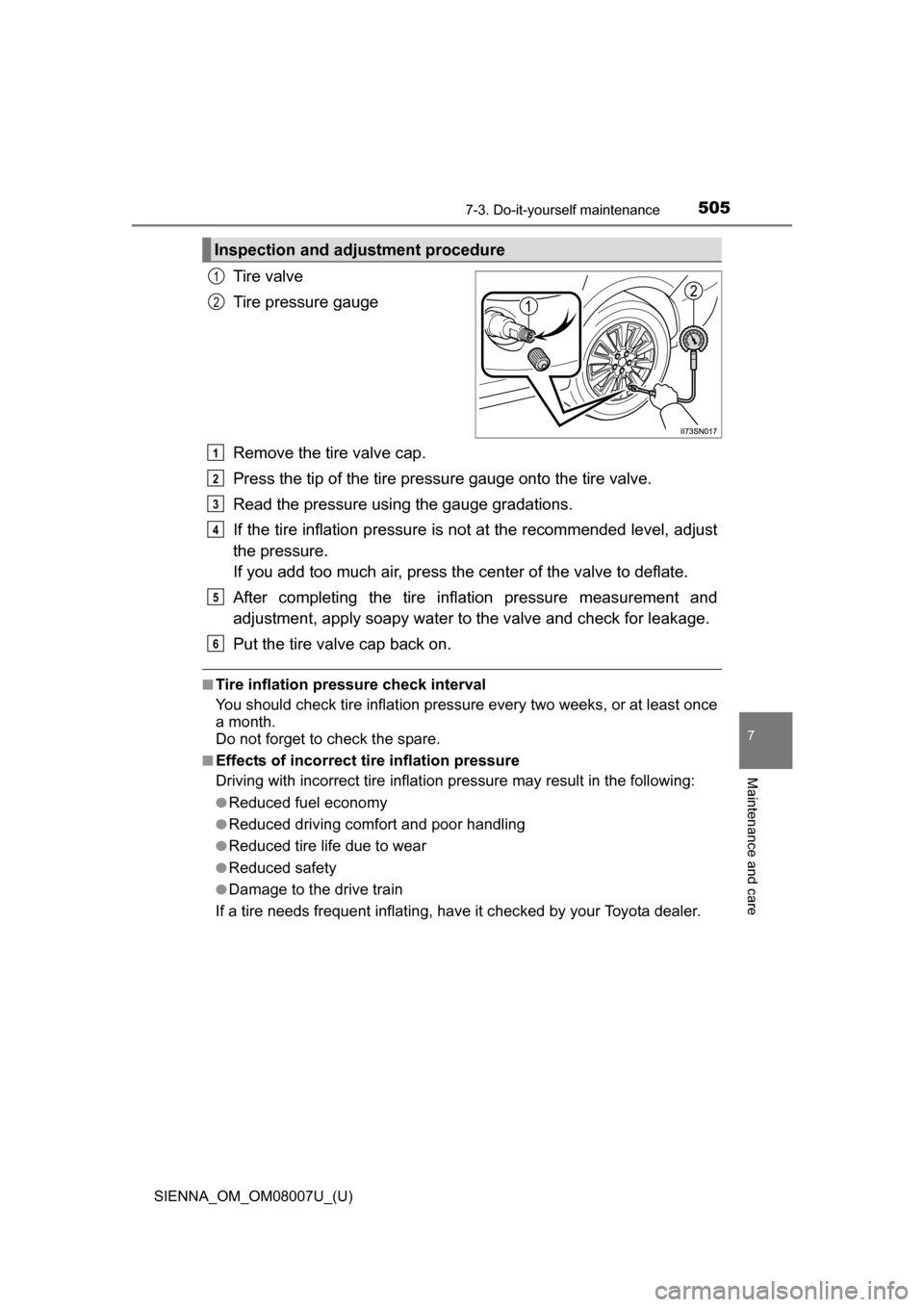
SIENNA_OM_OM08007U_(U)
5057-3. Do-it-yourself maintenance
7
Maintenance and care
Tire valve
Tire pressure gauge
Remove the tire valve cap.
Press the tip of the tire pressure gauge onto the tire valve.
Read the pressure usi ng the gauge gradations.
If the tire inflation pressure is not at the recommended level, adjust
the pressure.
If you add too much air, press the center of the valve to deflate.
After completing the tire inflation pressure measurement and
adjustment, apply soapy water to the valve and check for leakage.
Put the tire valve cap back on.
■Tire inflation pressure check interval
You should check tire inflation pressure every two weeks, or at least once
a month.
Do not forget to check the spare.
■Effects of incorrect tire inflation pressure
Driving with incorrect tire inflation pressure may result in the following:
●Reduced fuel economy
●Reduced driving comfort and poor handling
●Reduced tire life due to wear
●Reduced safety
●Damage to the drive train
If a tire needs frequent inflating, have it checked by your Toyota dealer.
Inspection and adjustment procedure
1
2
1
2
3
4
5
6
Page 547 of 672
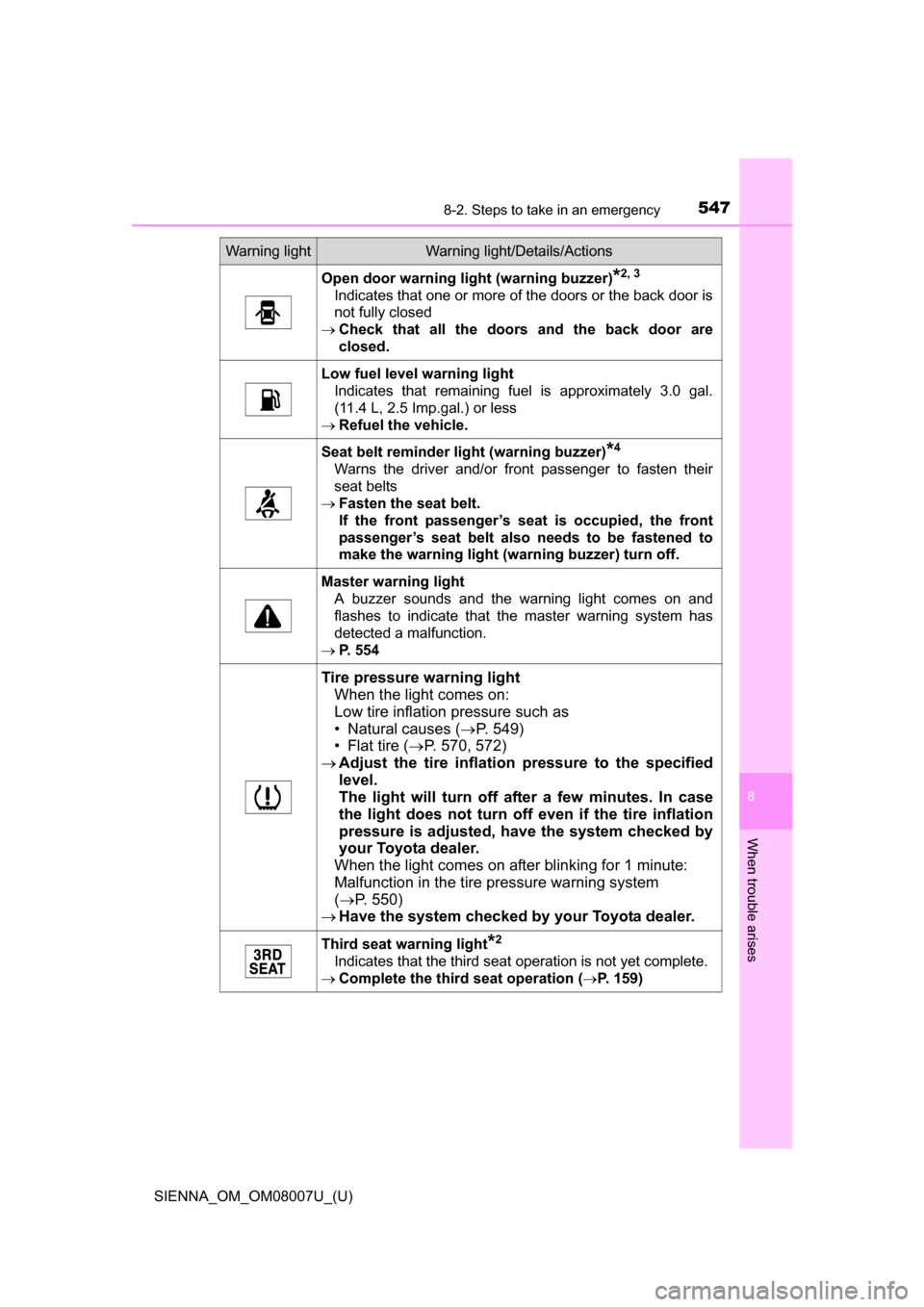
5478-2. Steps to take in an emergency
SIENNA_OM_OM08007U_(U)
8
When trouble arises
Open door warning light (warning buzzer)*2, 3
Indicates that one or more of the doors or the back door is
not fully closed
Check that all the doors and the back door are
closed.
Low fuel level warning light
Indicates that remaining fuel is approximately 3.0 gal.
(11.4 L, 2.5 Imp.gal.) or less
Refuel the vehicle.
Seat belt reminder light (warning buzzer)*4
Warns the driver and/or front passenger to fasten their
seat belts
Fasten the seat belt.
If the front passenger’s seat is occupied, the front
passenger’s seat belt also needs to be fastened to
make the warning light (warning buzzer) turn off.
Master warning light
A buzzer sounds and the warning light comes on and
flashes to indicate that the master warning system has
detected a malfunction.
P. 554
Tire pressure warning light
When the light comes on:
Low tire inflation pressure such as
• Natural causes ( P. 549)
• Flat tire ( P. 570, 572)
Adjust the tire inflation pressure to the specified
level.
The light will turn off after a few minutes. In case
the light does not turn off even if the tire inflation
pressure is adjusted, have the system checked by
your Toyota dealer.
When the light comes on after blinking for 1 minute:
Malfunction in the tire pressure warning system
( P. 550)
Have the system checked by your Toyota dealer.
Third seat warning light*2
Indicates that the third seat operation is not yet complete.
Complete the third seat operation ( P. 159)
Warning lightWarning light/Details/Actions
Page 549 of 672

5498-2. Steps to take in an emergency
SIENNA_OM_OM08007U_(U)
8
When trouble arises
■SRS warning light
This warning light system monitors the airbag sensor assembly, front impact
sensors, side impact sensors (front door), side impact sensors (rear), driver’s
seat position sensor, driver’s seat belt buckle switch, front passenger occu-
pant classification system (ECU and sensors), “AIR BAG ON” indicator light,
“AIR BAG OFF” indicator light, front passenger’s seat belt buckle switch, seat
belt assemblies, airbags, interconnecting wiring and power sources. ( P. 36)
■ Front passenger detection sensor, seat belt reminder and warning
buzzer
● If luggage is placed on the front passenger seat, the front passenger detec-
tion sensor may cause the warning light to flash and the warning buzzer to
sound even if a passenger is not sitting in the seat.
● If a cushion is placed on the seat, the sensor may not detect a passenger,
and the warning light may not operate properly.
■ If the malfunction indicator la mp comes on while driving
First check the following:
● Is the fuel tank empty?
If it is, fill the fuel tank immediately.
● Is the fuel tank cap loose?
If it is, tighten it securely.
The light will go off after several driving trips.
If the light does not go off even after several trips, contact your Toyota dealer
as soon as possible.
■ Electric power steering system warning light (warning buzzer)
When the battery charge becomes insufficient or the voltage temporarily
drops, the electric power steering system warning light may come on and the
warning buzzer may sound.
■
When the tire pressure warning light comes on
Check the tire inflation pressure and adjust to the appropriate level. Push-
ing the tire pressure warning reset switch will not turn off the tire pressure
warning light.
■The tire pressure warning light may come on due to natural causes
The tire pressure warning light may come on due to natural causes such
as natural air leaks and tire inflation pressure changes caused by temper-
ature. In this case, adjusting the ti re inflation pressure will turn off the
warning light (after a few minutes).
Page 552 of 672
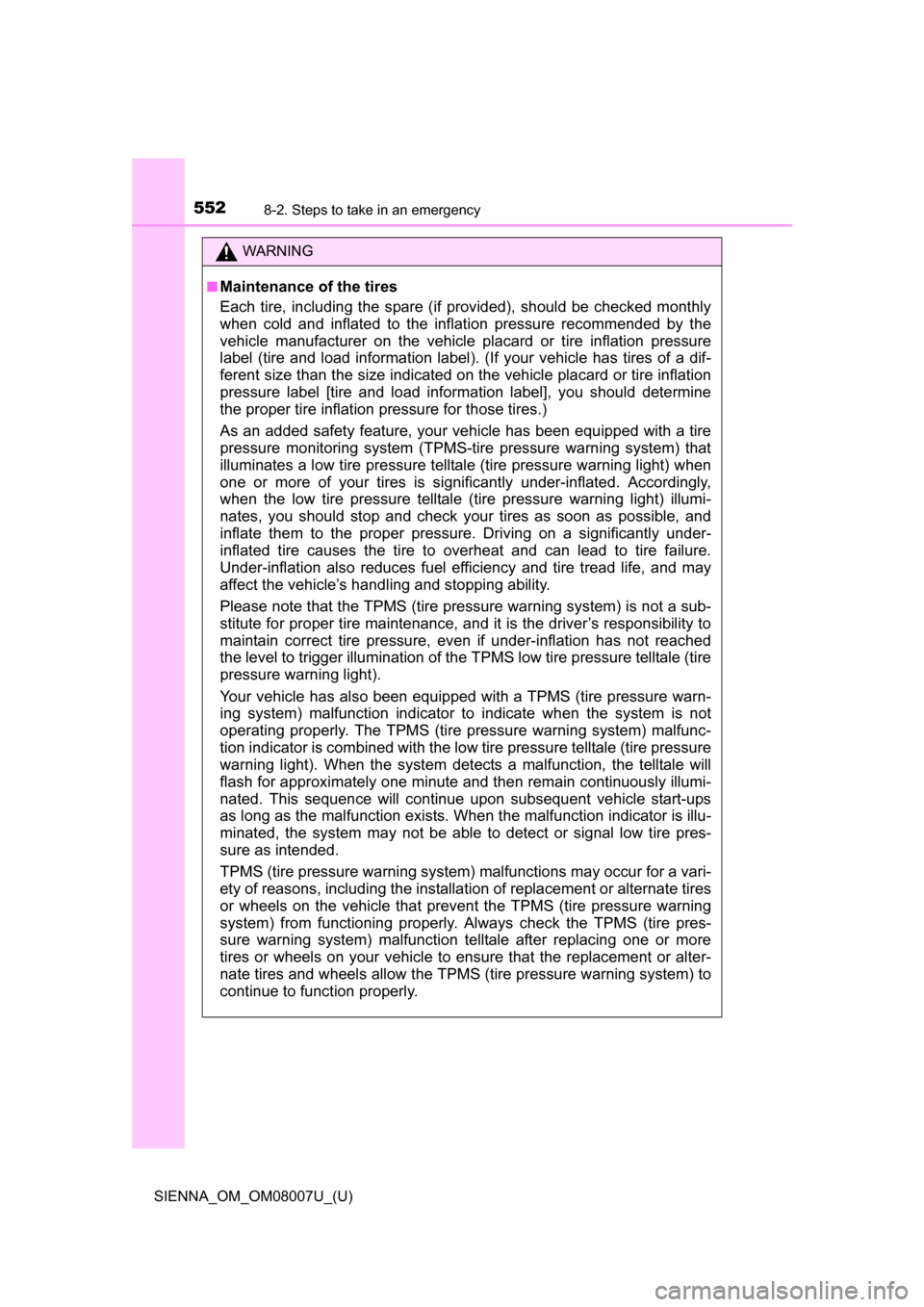
5528-2. Steps to take in an emergency
SIENNA_OM_OM08007U_(U)
WARNING
■Maintenance of the tires
Each tire, including the spare (if provided), should be checked monthly
when cold and inflated to the inflation pressure recommended by the
vehicle manufacturer on the vehicle placard or tire inflation pressure
label (tire and load information label). (If your vehicle has tires of a dif-
ferent size than the size indicated on the vehicle placard or tire inflation
pressure label [tire and load information label], you should determine
the proper tire inflation pressure for those tires.)
As an added safety feature, your vehicle has been equipped with a tire
pressure monitoring system (TPMS-ti re pressure warning system) that
illuminates a low tire pre ssure telltale (tire pressure warning light) when
one or more of your tires is significantly under-inflated. Accordingly,
when the low tire pressure telltale (tire pressure warning light) illumi-
nates, you should stop and check your tires as soon as possible, and
inflate them to the proper pressure. Driving on a significantly under-
inflated tire causes the tire to overheat and can lead to tire failure.
Under-inflation also reduces fuel effi ciency and tire tread life, and may
affect the vehicle’s hand ling and stopping ability.
Please note that the TPMS (tire pres sure warning system) is not a sub-
stitute for proper ti re maintenance, and it is the driver’s responsibility to
maintain correct tire pressure, even if under-inflation has not reached
the level to trigger illumina tion of the TPMS low tire pressure telltale (tire
pressure warning light).
Your vehicle has also been equipped with a TPMS (tire pressure warn-
ing system) malfunction indicator to indicate when the system is not
operating properly. The TPMS (tire pressure warning system) malfunc-
tion indicator is combined with the lo w tire pressure telltale (tire pressure
warning light). When the system dete cts a malfunction, the telltale will
flash for approximately one minute and then remain continuously illumi-
nated. This sequence will continue up on subsequent vehicle start-ups
as long as the malfunction exists. When the malfunction indicator is illu-
minated, the system may not be able to detect or signal low tire pres-
sure as intended.
TPMS (tire pressure warning system) malfunctions may occur for a vari-
ety of reasons, including the installati on of replacement or alternate tires
or wheels on the vehicle that prevent the TPMS (tire pressure warning
system) from functioning properly. Always check the TPMS (tire pres-
sure warning system) malfunction te lltale after replacing one or more
tires or wheels on your vehicle to ensure that the replacement or alter-
nate tires and wheels allow the TPMS (tire pressure warning system) to
continue to function properly.